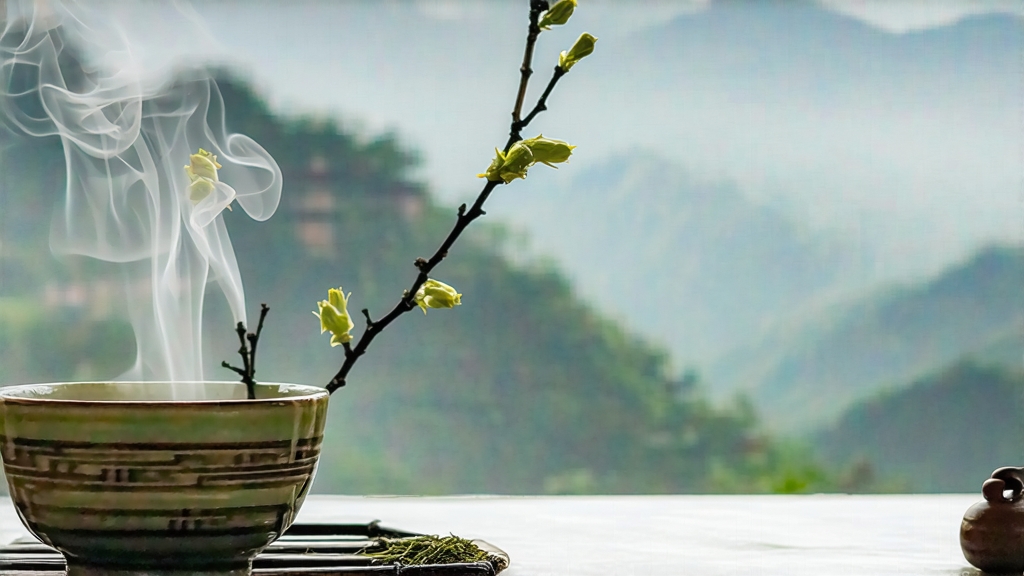
High above the Sichuan Basin, where the Min River bends like a jade ribbon through perpetual cloud, the Meng Ding Shan range has been whispering tea secrets for twelve centuries. Among its seventeen mist-shrouded peaks, the tiny village of Ya’an cradles the oldest surviving yellow tea on earth: Meng Ding Huang Ya, the “Yellow Bud of Meng Mountain.” Unlike the green teas that later stole the limelight, this yellow gem was never meant for loud commerce; it was bred in the quiet of monasteries, offered to Tang emperors, and hidden inside bamboo tubes carried by horse caravans bound for Lhasa. To taste it today is to sip the slow, golden minutes of Chinese history itself.
Historical scrolls kept at the mountain’s Ganlu Temple record that the monk Wu Lizhen planted seven tea bushes on the summit in 53 BCE, believing the altitude—1,450 m above sea level—brought his herbs closer to the palace of the Jade Emperor. By the Tang dynasty (618-907 CE) those bushes had become state property; their spring buds were rushed 1,400 km to Chang’an within six days, carried by relay riders who changed horses every twenty li. The Song emperor Huizong, himself a gifted tea artist, declared Meng Ding Huang Ya one of the eight “tribute teas” in 1115 CE, and Ming dynasty bureaucrats refined the sealed-yellowing technique that gives the leaves their luminous straw colour. When the Qing court switched to fragrant green teas in the 18th century, production shrank to a few kilos reserved for local monks and Tibetan lamas; only in 1959 did the Sichuan government revive the craft, establishing a small state farm that still follows the ancient rhythm of two harvests a year—before Qingming in early April and before Guyu two weeks later.
The cultivar itself is a local landrace known as “Meng Ding Xiao Ye Zhong,” a small-leaf camellia sinensis var. sinensis that has acclimated to cool, foggy mornings and ultraviolet-rich afternoons. Because the mountain traps moisture, the buds grow slowly, accumulating theanine and aromatic esters while keeping catechins relatively low; the result is a naturally sweet, almost milky cup without the grassy bite common to early-picked greens. Farmers select only the unopened needle with one just-unfurling leaf, plucked at dawn when dew still pearls the cilia. A master picker can gather barely 400 g in a day, the exact quantity needed to finish one bamboo tray of Huang Ya.
Crafting Meng Ding Huang Ya is a dance of restraint. The moment the basket reaches the cottage, the buds are spread three centimetres deep on woven rattan and left to wilt for ninety minutes; mountain breeze lowers their moisture from 78 % to 68 % without bruising the downy tips. Next comes the first firing—exactly 140 °C for four minutes in a cast-iron wok—hand-tossed thirty-six times to kill green enzymes while locking in a faint maillard nuttiness. What follows is the step that gives yellow tea its name: sealed yellowing. The warm leaves are piled 8 cm deep inside a cedar box lined with wet linen, then slid into a 28 °C fermentation chamber for 48 hours. During this enclosed “sweat,” chlorophyll quietly oxidises into pheophytin, catechins dimerise into softer theaflavins, and a microscopic bloom of thermophilic yeasts generates honeyed lactones. Every twelve hours the master lifts the lid, fans away excess heat, and inhales: the scent must move from fresh orchid to ripe apricot without ever touching the damp compost aroma that signals over-fermentation. A second, lower-temperature drying at 80 °C for two hours sets the colour to pale champagne and reduces moisture to 5 %. Finished leaves are straight, slim needles, 15–20 mm long, the colour of antique parchment and covered in a silvery pubescence that glints under light.
To brew Meng Ding Huang Ya you need calm water and a steady wrist. Start with a celadon gaiwan; its crackled glaze softens the liquor while its pale green body amplifies the tea’s golden hue. Weigh 3 g of dry buds—about a level teaspoon—and rinse them with 75 °C water for five seconds; this “awakening” pour removes surface dust and coaxes the first aroma burst. The